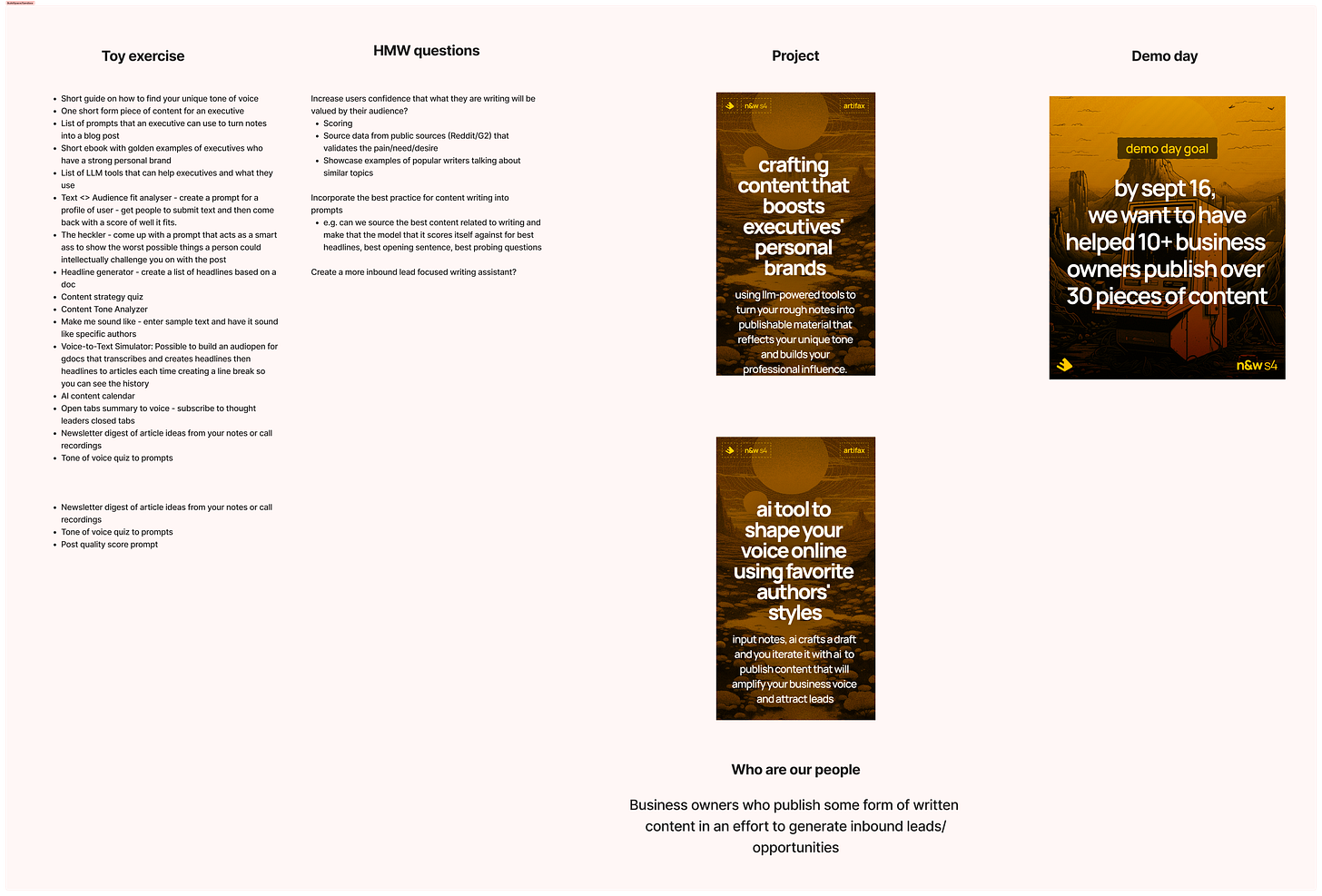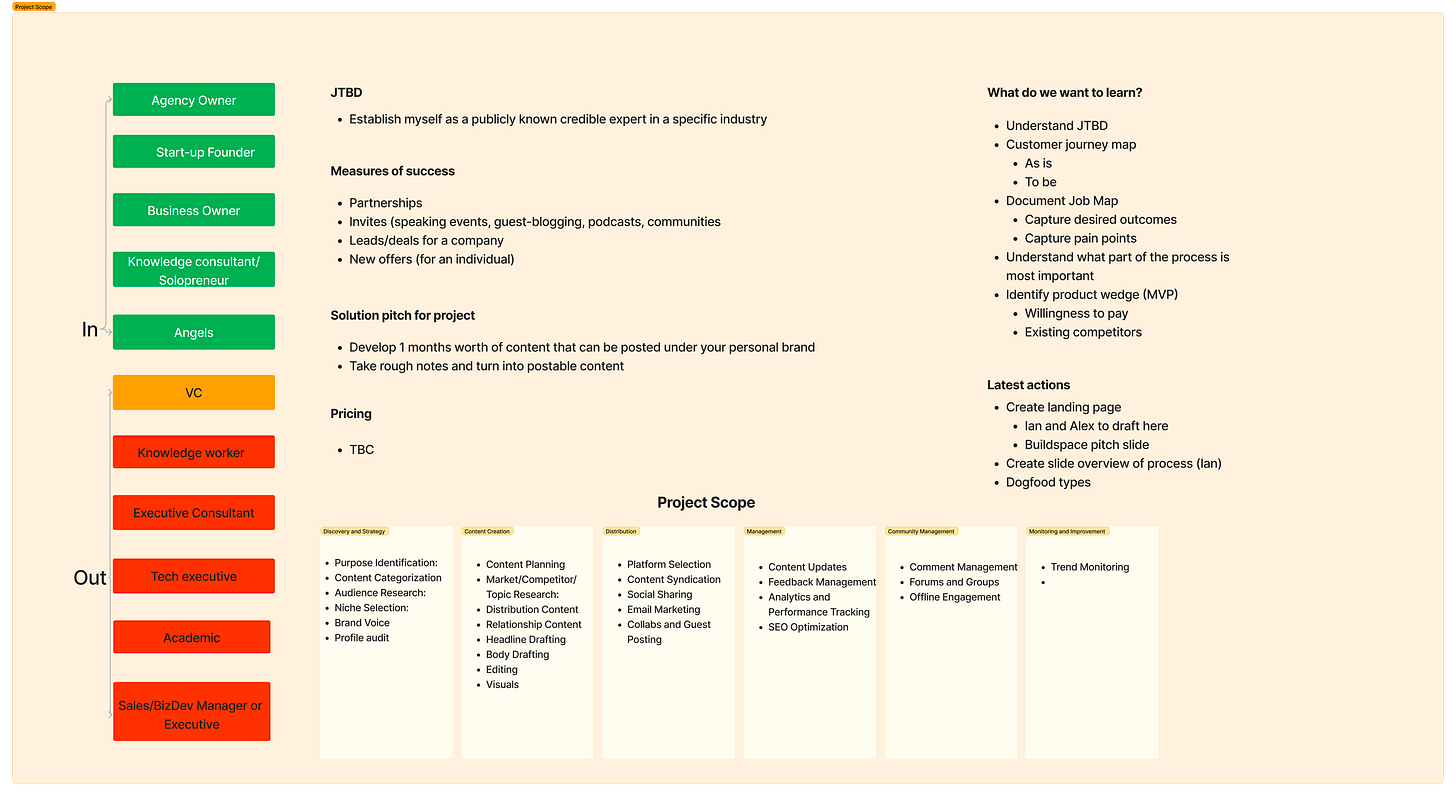In Q4 of 2023,
and I teamed up and closed sales of $1,000 Per User with only a Notion page (V2) and phone calls. In fact, we told our target customers that we didn’t know if this would even work, and they still sent us their money before they received anything. The audio of this talks about the real-life use case and how we did it, and the post itself is a framework you can take and apply to your next project.Background context to the Artifax project
Alex and I were avid writers and wanted to discover a way to make it easier for us and others to reduce the friction in sharing complex ideas. We hypothesized that as AI-generated content flooded the internet, there would be a higher demand for human ‘authoritative curators’ to help us understand what content to listen to. We believed that by reducing the friction in creating technical content, we could make it possible for experts to become authoritative curators in their domain. We used this sales sprint framework to validate if there was a demand for a technical ghostwriter in your pocket.
The Sales Sprint Framework
Our Sales Sprint is modeled after the Google Ventures Design Sprint and is a concentrated, short-term effort to test and refine startup ideas through direct market engagement. This approach combines rapid iteration with real-world feedback, allowing founders to validate hypotheses and adapt strategies quickly. The framework outlined below is tailored for founders keen on testing new ideas efficiently and effectively. We have mapped it over five days for simplicity; however, in reality, you will have to work around the schedules of your prospects.
Day 1: Understand
Sprint Questions: Identify core sales objectives and hypotheses. Who is our target customer, and what unique value do we offer?
Exercises:
Set SMART Sales Objectives: Use tools like Figma to organize and track your sales objectives for easy collaboration.
Develop Testable Hypotheses: Utilize SimilarWeb to analyze website traffic and customer behavior as a basis for your hypotheses.
Customer Interviews: Leverage your existing network for initial interviews, creating a structured questionnaire to gather consistent data. The first version of this post dives deeper into how to structure this.
Willingness to Pay (WTP) Interviews: Schedule interviews, guiding the conversation with pre-planned questions about budget and current solution expenditures. WTP strategies include:
Understanding spending on existing solutions
Quantifying the value of additional leads/customers your solution provides
Calculating the cost of time/opportunity cost your solution saves
Benchmarking value against other comparable solutions they pay for
Van Westendorp Price Sensitivity Meter questions
Day 2: Diverge
Sprint Questions: Develop impactful sales collateral and outreach strategies. How can we engage our target prospects effectively?
Exercises:
Tailor Sales Collateral: Use Notion/Canva to design sales materials that resonate with your target buyer personas.
Incorporate Storytelling: Draft your narratives in Google Docs, enabling team feedback and collaboration.
Develop Lead Scoring Criteria: Utilize a basic CRM to categorize and score leads based on engagement and fit.
Plan Personalized Outreach: Do everything manually at first; automation is unnecessary during this stage.
Speak with competitors: Use secret shopper methods to speak with competitors. Being transparent with competitors at a similar stage can be advantageous in sharing insights or identifying synergies where you can generate leads for one another.
Day 3: Engage and adapt
Sprint Questions: Effectively engage prospects and establish a feedback loop. Based on insights, how can we adapt our approach?
Exercises:
Direct engagement: Reach out to 10-15 prospects daily with personalized messages or calls. Use direct, concise language that addresses their specific needs.
Use your existing email client or phone. The goal is to start conversations, not manage a sales funnel.
Gather Feedback: Ask for specific feedback on your value proposition and pricing for each interaction. Note hesitations or objections.
Keep a simple text document or spreadsheet to jot down feedback themes quickly.
Adapt Quickly: Identify common feedback themes. Adjust your pitch or offer accordingly for the next set of outreach.
Test Payment Willingness: For interested prospects, propose a simplified pre-order or deposit process to gauge payment willingness.
A simple PayPal link or a verbal agreement can suffice at this stage to test commitment.
Day 4: Iterate and validate
Sprint Questions: How can we iterate our sales approach rapidly based on customer feedback to maximize value?
Exercises:
Refine Your Pitch: Revise your sales pitch to incorporate feedback. Highlight solutions to previously raised objections.
Keep revisions in a single document for easy access and modification. Use clear, jargon-free language.
Validate Changes: Use your revised pitch to contact a new set of 10-15 prospects. Measure the change in response rate and interest.
Personal follow-ups or brief calls can provide immediate validation or further refinement cues.
Simplify Offers: Based on feedback, simplify your offer to make it more attractive and more accessible for your prospects to understand.
Focus on the core benefits. Remove any unnecessary complexity that might deter decision-making.
Quick Decision Making: Based on today's interactions, decide whether to pivot, persevere, or halt. Use direct customer feedback as your guide.
Make decisions based on patterns in feedback rather than outliers. Look for consistent signals.
Day 5: Evaluate and Scale
Sprint Questions: Assess the effectiveness of our Sales Sprint. How do we measure success and plan for scalability?
Exercises:
Assess Sprint Outcomes: Review the key metrics from your sprint, such as conversion rate, feedback themes, and willingness to pay. Summarize the insights gained.
Make Data-Driven Decisions: Based on your assessment, decide whether to pivot your approach, continue testing with refinements, or scale the current strategy.
Look for clear patterns in your data and feedback to guide your decision. Consistency in positive signals is a green light for scaling.
Plan for Scaling: If deciding to scale, outline a simple plan to expand your outreach. Identify key actions, such as hiring, training, or increasing your marketing spend.
Start with low-hanging fruits, like automating parts of your outreach with basic email scheduling tools or expanding your prospect list through networking.
Document and Share Learnings: Compile the lessons learned, successful practices, and areas for improvement from this sprint. Share these insights with your team.
Create a concise report or presentation to communicate your findings. Focus on actionable insights that can inform future strategies.
Celebrate & Reflect: Recognize the effort and progress made, regardless of the outcome. Reflect on the sprint process and how it can be optimized for future iterations.
By following this process, founders can leverage their existing networks, gather insights from their target audience, and make data-driven decisions about pivoting, persevering, or scaling their efforts before building product. While the sprint may seem intense, it ultimately saves time and resources by quickly identifying viable paths to market or revealing the need for pivots before significant investments are made.
What methods have you used to validate demand prior to building? Please share them in the comments.




















Share this post